ناگفته های تمدن جیرفت
Jiroft_culture
ناگفته های تمدن جیرفت
تمدن باستانی جیرفت
Doç. Dr. Haluk BERKMEN
Archeologists long assumed that the cradle of civilization was southern
Mesopotamia where 5,000 years old Sumerian texts and objects were
found. But the origin of the Sumerian civilization is to a large extent
unknown. We are now in the position to demonstrate that the Sumerian
script owes its origin to the Central Asiatic pictographic seals.
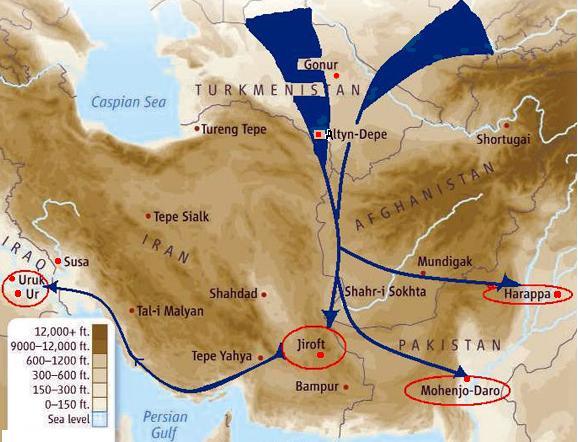
A Science Magazine article entitled Middle Asia Takes Center Stage (1) claims the following:
Long dismissed as a backwater, the vast area between Mesopotamia and
the Indus Valley is now revealing a tapestry of wealthy urban centers
that shaped humanity’s first concerted attempt at city life.
The article claims that instead of retelling the traditional story that
civilization sprouted in Mesopotamia, archeologists began to assemble a
far more complex picture in which dozens of urban centers thrived
between Mesopotamia and the Indus Valley, adopting each others
architecture and ideas. This was possible because all these urban
centers could communicate in a common language which can be defined as
the Proto-language.
Below we see a map of the region defined as
Middle Asia. The common culture of this region starts from
Turkmenistan, Uzbekistan and Kazakhstan in the north and includes
Afghanistan, Iran and Pakistan ending in southern Mesopotamia. The
arrows indicate the expansion route along rivers and sea coasts adopted
by the early settlers some 6,000 years B.P
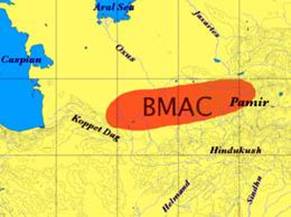
In an article entitled: Neglected Civilisation Grabs Limelight, Andrew Lawler says (2):
Four thousand years ago along the banks of the ancient Oxus River,
which now separates Afghanistan from Uzbekistan, there were people who
lived in vast compounds protected by high wall, produced their own
bronzes, and stone seals, and traded their wares as far as the Persian
Gulf and Palestine. Although these people would have been key players in
Bronze Age Central Asia, their civilization remains an enigma because
of 20th century politics.
The vast territories in which this
Central Asian civilization flourished have been defined as the
Bactrian-Margiana Archeological Complex (BMAC) by Fredrik Hiebert and
Victor Sarianidi who lead excavations in the region. “We are redefining
the boundary of Central Asia” says Hiebert and claims that a single
culture thrived in these regions. The original name of Bactria is Belh
and the original name of Margiana is Merv. Both cities are ancient
cultural centers of Turkic as well as Persian people. The correct
definition of this vast region should be Belh-Merv Archeological
Complex, but as A. Lawler says; politics was and is still influencing
Archeology. Below we see the extent of the region defined as BMAC
کتیبه ی آجری یافت شده در جیرفت
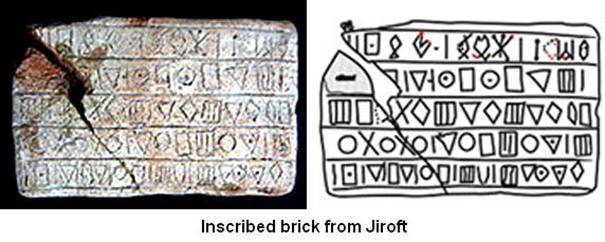
One
of the important cultural sites discovered in BMAC is Altyn Depe, which
means “golden hill” in Turkish (see map at the top of the page). When
archeologists excavated this site they found a mud brick altar, built
3,200 years ago as a temple for worship of fire (3). The fire altar and
several golden artifacts found in this site give strong support to the
claim that the sun-worshiping people came to these regions from the
north. The golden ibex found in Altyn Depe (below) is more than a simple
piece of ornament, but is rather an important clue for the Central
Asiatic origins of this culture (see Chapter 3, The Hidden Meaning of
Pertoglyphs).
The Uighur people of the ancient times followed
the shallow river banks and pushed forward into the southern regions of
BMAC in order to build new settlements. One such important cultural
center is the city of Jiroft located in the south of present Iran. In
the picture below we see a pot excavated in Jiroft on which a horned man
with the feet of a bull is carved. We will find this same symbolism in
different parts of the world, forming a strong support for a common
Asiatic origin.
Below we see an inscribed brick from Jiroft.
This script is totally unknown to the scholars and is waiting
decipherment. The inscriptions on three mud bricks found until now could
well be the Asiatic seal-based writing system predating the Sumerian
cuneiforms as well as Linear Elamite, another script from Susa (see map
above and also Chapter 13, Evolution of Writing Systems).
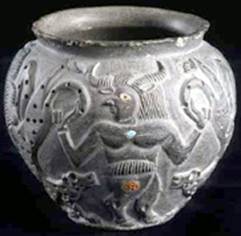
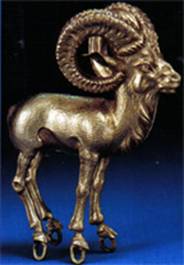
References
(1) Science Magazine, Volume 317, page 586, 3 August 2007.
(2) Science Magazine, Volume 302, page 979, 7 November 2003.
(3) National Geographic Magazine, Volume 177, page 58, March 1990.